Excerpts from Jim Conrad's
Naturalist Newsletter
entry dated April 9, 2022, issued from near Tequisquiapan, elevation about 1,900m (6200 ft), ~N20.57°, ~ W99.89°, Querétaro state, MÉXICO
YERBA DE PASMO
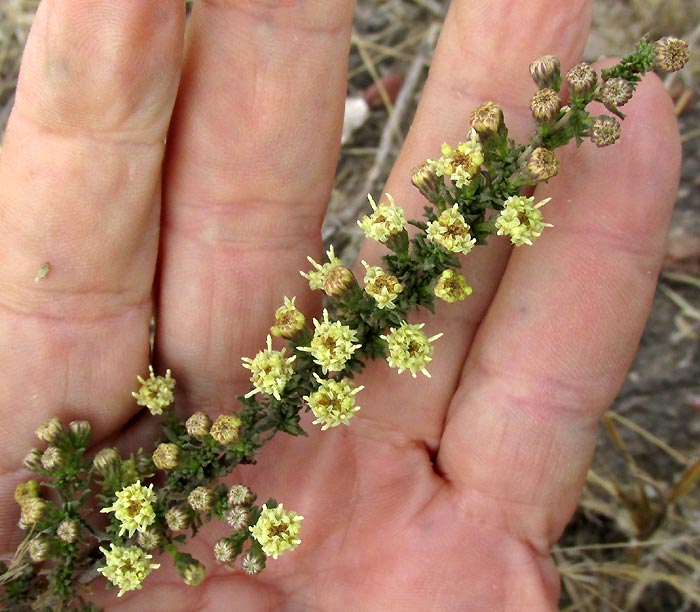
Now during the dusty, sun-bleached late dry season, beside a foot trail along a barbed-wire fence surrounding an overgrazed, scrubby, parched pasture, a knee-high, woody, densely branched shrub about knee high bore the above flowering heads. Tiny flowers gathered in compact heads all along the brittle stems announced yet another member of our most abundantly represented plant family, the Composite or Aster Family, the Asteraceae. However, the vast majority of that family are herbaceous species, so that's a big help for identifying this very brittle, woody one.

Above, a closer look at the heads shows something noteworthy: florets with star-shaped disc corollas along the perimeter of each head produce fuzzy, white, fingerlike style branches extending beyond the fused anthers below them, while in the heads' centers it's hard to say what's going on. Later I'm to learn that here we have a genus in which some florets are fruit-producing female, or pistillate, while others are male, or staminate, not producing fruits. Also note that there are no flat-bladed ray flowers, just cylindrical disc flowers. These features go a long way toward narrowing in on the identification.
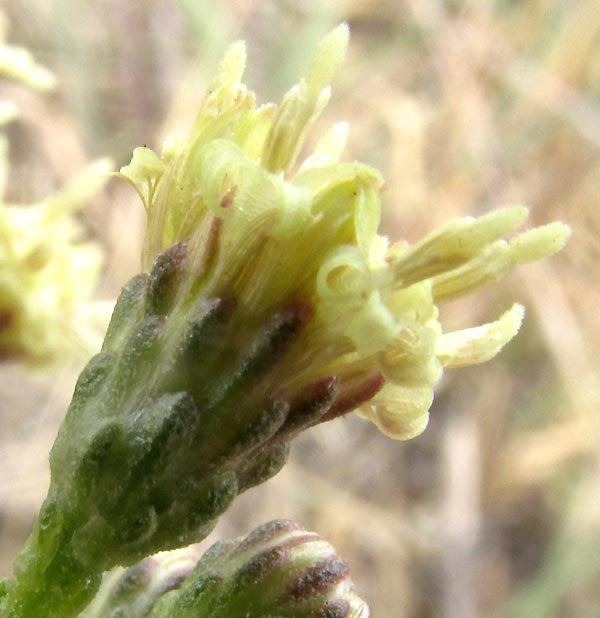
Above, the green involucre is composed of spirally arranged bracts of different sizes overlapping like shingles on a roof, and that's another important field mark, for bracts come in all shapes, textures and arrangements.
At this point it dawned on me that among the relatively few woody Composite Family members I know is one with creamy-white flowering heads and involucres with bracts very similar to these, and that's the genus Baccharis, commonly known as baccharises or "brooms." Baccharis species produce cypsela-type fruits bearing white "parachutes" of tufted hairs atop them, for wind dispersal. No fruiting heads appeared on this plant, but, below, a split-open head shows that atop each developing ovary there's a crown of slender, whitish hairs, the pappus, which develop into the parachutes.
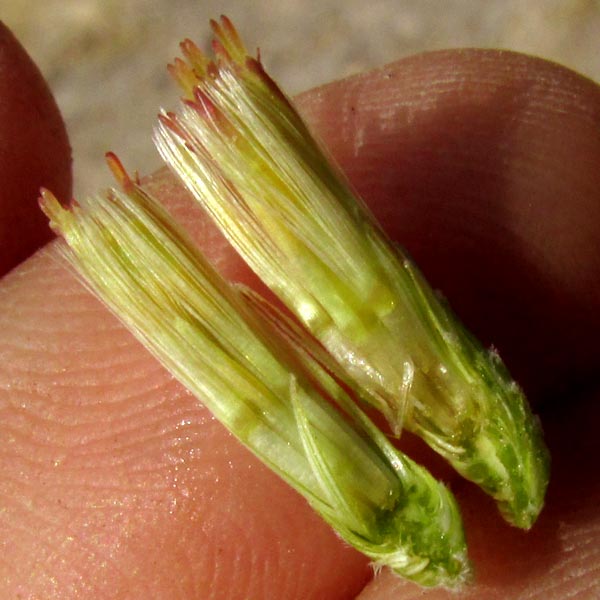
Remembering Baccharis was helpful because the part of the gigantic Composite Family Baccharis belongs to isn't published yet in floras covering this area, so I couldn't "key out" our plant. However, various lists of identified species can be found for nearby areas with similar environments, and on one of those a Baccharis species was listed looking like our plant. That species, BACCHARIS PTERONIOIDES, bears small, thick leaves with 1-5 pairs of teeth on the margins, and our species had those, shown below:
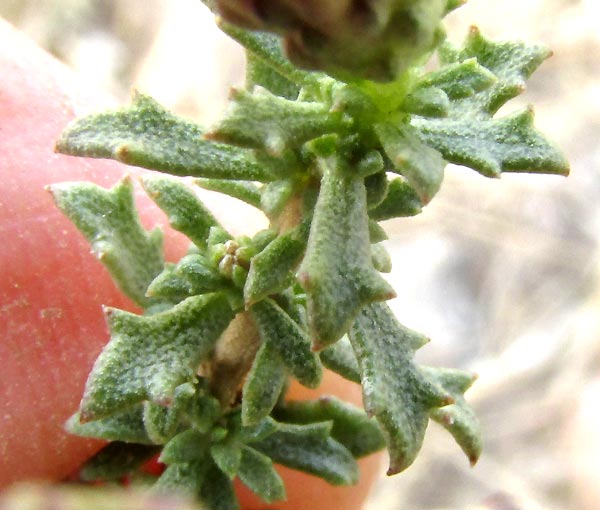
In Spanish this bush is called Yerba de Pasmo, meaning something like "Chill Plant," since pasmo refers to the kinds of chills sick people can have. An infusion of the leaves is supposed to deal with them. After seeing the tiny bumps covering the above leaves, it's not surprising that the shrub has a medicinal use, since such bumps often are glands of aromatic oils and such containing chemical compounds mainly to make the leaves unpalatable to grazers. Infusions also are used to treat skin sores, and some say that the plant is poisonous to cattle and sheep. That may explain why, as I was photographing the plant, an old campesino came down the trail pushing his bike and when I explained that I was interested in the plant, he said, waving his arms, "Eh, it's no good, cut it down, cut it down!"
Yerba de Pasmo occurs from Arizona, New Mexico and Texas in the US arid southwest through arid, south through upland Mexico to Oaxaca in the south.
Entry from field notes dated June 29, 2023, taken along one-lane gravel road in valley between Puerto del Zenthé and Chavarrías in mountainous area with a maze of roads too complex to say how to get there; in general it's in the mountains of east-central Querétaro state, municipality of Cadereyta de Montes, 12 straight-line kms due east of Vizarrón de Montes but much farther by twisting roads; juniper-scrub forest; limestone bedrock; elevation ~2860m (~9400 ft), Querétaro, MÉXICO, (N20.84122°, W99.60509°)
MORE PIX, LATER IN SEASON
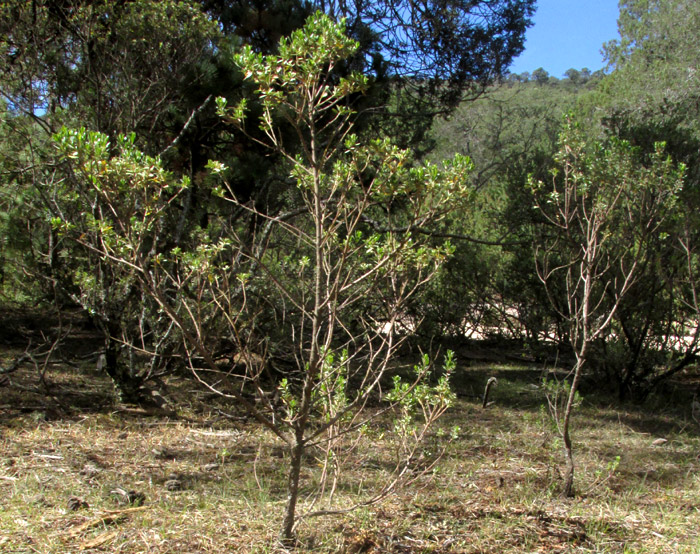
Later, up in the mountains, the same species turns up, but it's later in the year and displays the erect, small-tree habit shown above. Its being in a partly shaded, semi-open spot often grazed by roaming cattle may help explain its spindliness. It's about 1.2m tall (4ft). Here's a mid-level leaf:

No flowers were present but at the tip of a branch a single fruiting head had matured and was releasing its parachuted, cypsela-type fruits:
